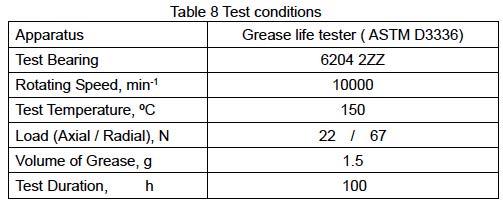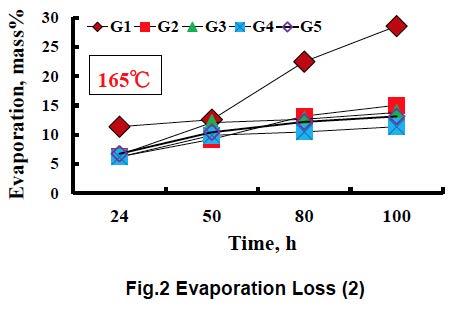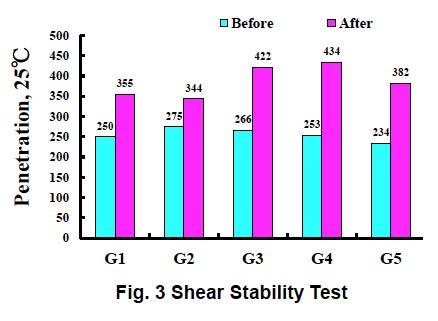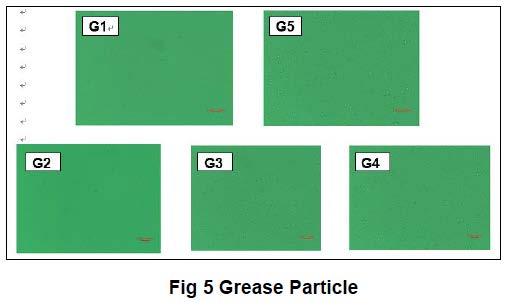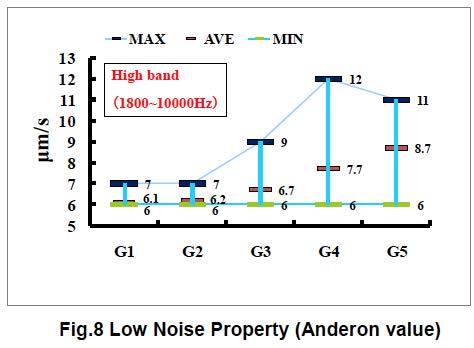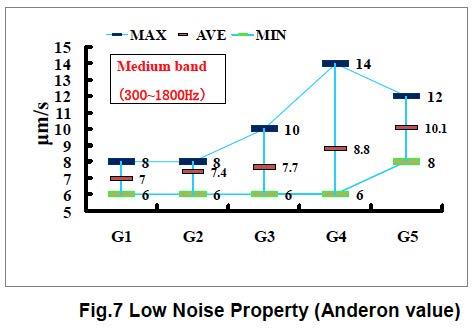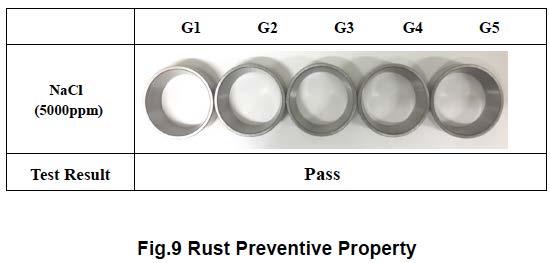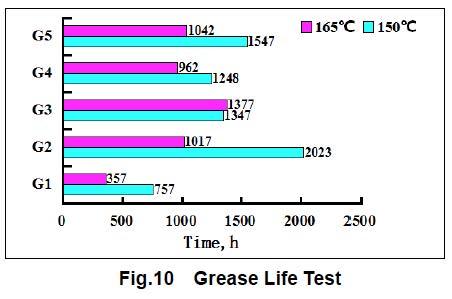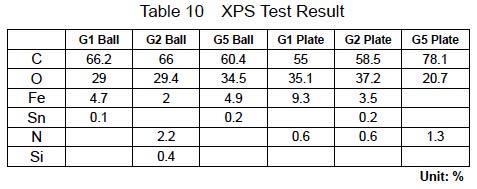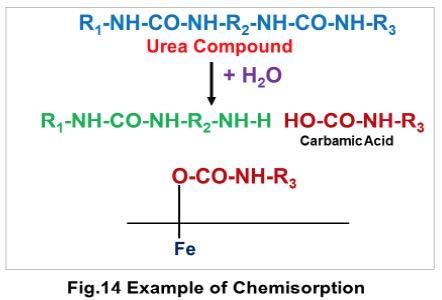
10 minute read
A STUDY ON A HYBRID GREASE OF A LITHIUM GREASE AND A DIUREA GREASE Applied for Wide Temperature Range
This paper was published in the Sept/Oct issue of the Spokesman; However, some content from the paper was missing. Please see the revised technical paper below. We apologize for any inconvenience.
Author: You Shu Ting, Co-authors: Chen ShiQi, Ng Hak Hong Seiji Okamura Hin Leong Trading (PTE) Ltd. Singapore
Abstract
It is well known that lithium grease shows good low noise property, but is poor in grease life at higher temperature than 150 ºC. On the contrary, urea grease shows longer grease life at high temperature. But urea grease is poor in low noise property.
As to five sample greases which consist of lithium soap(A) and ester oil, diurea(B) and ester oil and mixed thickener(A+B) and ester oil, we evaluated them on the items related to actual performance applied for shield/sealed bearings.
They are grease life, thermal stability (thin film evaporation test), low noise property (Grease particle, dB value, Anderon value), shear stability, rust preventiveness and low temperature property.
We developed the well-balanced grease (Hybrid grease) by blending lithium grease and diurea grease (blend ratio, A/ B=75/25). This grease showed longer grease life by two to three times than lithium grease at 150 ºC and also showed good low noise property as the same as Lithium grease.
1. Introduction 2. Grease Sample preparation
We prepared five grease samples which consist of lithium soap /urea compound and ester oil as base oil. The base oil viscosity is approx. 30-40 mm2/s.
2.1. Lithium Grease
2.1.1. Li Grease Sample Preparation Procedure 1. Heat lithium soap (pre-made soap) in base oil with stirring until the temperature reaches almost 215 ºC. 2. Pour the hot material into cooling pan. 3. Add an oxidation inhibitor and rust inhibitors to the resulting mixture with stirring. 4. Treat the resulting mixture by three-roll mill. 5. Grease samples are prepared after filtration and deaeration.
2.2. Urea Grease
2.2.1. Urea Reaction
2.2.2 Urea Grease Sample Preparation Procedure (1) React on MDI with amines at 80~100ºC in base oil. (2) Heat the reaction product up to150-160 ºC with stirring and maintain it at this temperature for 30 minutes. (3) Cool it down to 80ºC with stirring and add an antioxidant and rust inhibitors. (4) Treated by three roll mill after cooled down to room temperature (5) Grease samples are prepared after filtration and deaeration.
On the one hand, It is well known that Li greases which have excellent low noise property are applied for electric motor bearing. Also, the market is demanding greases which are applied at higher temperature such as 150 ºC and above with low noise property. On the other hand, it is also well known that urea greases which have long life at high temperature are applied for various industrial fields, such as automobile, steel making plant and household appliances.
And also, as to urea greases, many test results on grease life at various high temperatures are reported1),2),3),4).
Generally speaking, low noise property of urea greases is not so good.
We studied on the possibility of balancing low noise property and long life performance at high temperature by choosing a suitable blend ratio of lithium grease and diurea grease.
In this paper, we defined the mixture of Li grease and Urea grease as Hybrid grease. This paper describes on the difference of performance (thermal stability, shear stability, low temperature property, low noise property, rust preventiveness and grease life) among five sample greases including three blended greases.
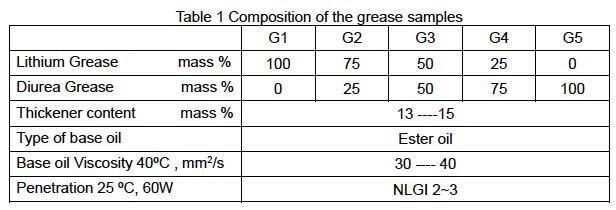
3. Evaluation
1. Physical properties are shown in Table 2 2. Thermal stability (Thin film evaporation test)
Making a thin film grease sample (Approx.1mm thickness and 50 mm in diameter on a steel plate) and put it in the oven. Measure the evaporation loss. The test conditions are shown in Table 3 3. Shear stability (ASTM D 1831 modified) The test conditions are shown in Table 4. 4. Low temperature characteristics
Low temperature torque at -40ºC (JIS K2220 18) 5. Low noise property 5.1. Particle size 5.2. Anderon value, dB value The test conditions are shown in Table 5 6. Rust preventive characteristics ( ASTM D 1743 modified) The test conditions are shown in Table 6. 7. Grease life test ( ASTM D 3336 modified) The test conditions are shown in Table 7. 8. Bearing leakage test. The test conditions are shown in Table 8. 9. Bearing surface analysis by XPS (X-ray Photoelectron Spectroscopy) The test conditions are shown in
Table 9.
4. Results and Discussion
4.1. Physical property
Physical property of the grease samples is shown in Table 2. Penetration of the grease samples is NLGI 2-3.
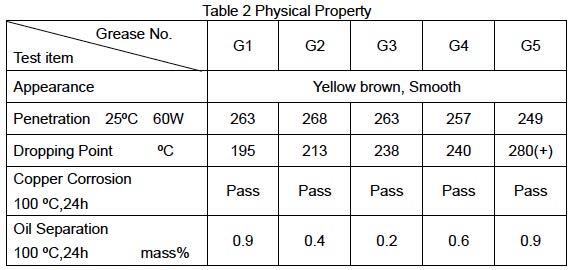
The dropping point varies with sample greases from 195 ºC to 280 ºC and above. As to the copper corrosion and the oil separation, there is not so much difference among samples.
4.2 Thermal Stability Thin film evaporation test

Thin film evaporation test was done as the following photos (before and after).
In the test results at 150 ºC, there is not so much difference among five grease samples G1-G5. But, in the test results at 165 ºC , G1 shows the higher evaporation loss by two to three times in comparison with other four greases (G2, G3, G4, and G5) which include urea grease.
Urea greases have good thermal stability.
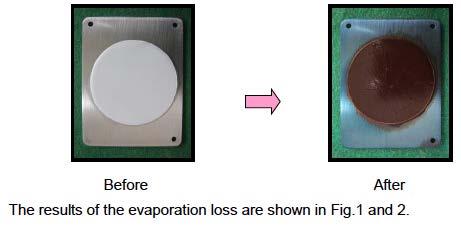
4.3 Shear stability (Shell Roll test)

The test results of G3 and G4 showed more than 400 in penetration. G1 and G2 showed better results, respectively, 355 and 344 in penetration. G2 was best among five grease samples. Usually, urea greases are apt to harden in penetration under high temperature. But by shearing, grease becomes softer in penetration.
If hardening does not occur under high temperature, the penetration after the test becomes softer. Then test results after shell roll test are easy to fluctuate.
The better grease such as G2 is well balanced in hardening and softening. Test results are shown in Fig.9. All the grease samples showed good results in 5000 ppm NaCl solution .There are no rust spots after the test.
4.7 Grease life test

4.4 Low temperature torque (JIS K2220 18)
Figure 4 shows the test results of starting torque at -40 ºC . G1, G2 and G3 showed better results among five samples. The reason why G4 and G5 show higher value than G1, G2 and G3 is that the unworked penetration of G4 and G5 may be harder.
4.5 Low noise property
4.5.1 Photos of grease particle
Micrographs of grease samples after three roll mill treatment are shown in Fig 5. In G1, we cannot find any particles, but G5 and G4 contain too many particles.
4.5.2 Bearing noise testers
The test conditions on dB value and Anderon value by bearing noise testers are shown in Table 5 and the test results are shown in Fig 6 and Fig. 7-8 respectively.
4.5.2.1 dB value dB value of G1 shows the lowest value and the dB value of G2 is near to G1. It becomes higher in order of G5>G4≧ >G3≫G2>G1. This may be based on a number of grease particle and the initial penetration (consistency).
4.5.2.2 Anderon value
G1 and G2 show almost the same value in both medium band and high band. G3, G4 and G5 show higher value than G1 and G2 and the value of G3, G4 and G5 are also fluctuating. G1 and G2 show good low noise property.
Figure 10 shows the test results of grease life at the temperature of 150 ºC and 165 ºC.
As to the test results at 150 ºC, G2 shows longest grease life
among five greases and G2 showed almost two to three times longer than that of G1. In 165 ºC, G2 shows longer grease life almost three times than that of G1.
Other grease samples including urea grease (G3, G4 and G5) also show longer life by almost 3 to 4 times in comparison with G1.
All the grease samples including urea grease are longer in grease life than G1.
5. General Evaluations
Fig.11 shows the general evaluation on three greases (G1, G2 and G5).
As to low temperature property and rust preventiveness, there is not so much difference among them. All the greases show better results.
G2 is superior to G1 in grease life , thermal stability and shear stability.
As to low noise property, G2 shows the better results almost as same as G1. It is said that G2 is well-balanced grease having many good properties.


6. Verification of the test results
G2 grease (hybrid grease) showed longer life by almost two to three times than that of G1 grease (Li grease). To verify the reason why G2 showed longer life, bearing leakage test and bearing surface analysis by XPS were done.
Bearing leakage test was done to look into
the leakage tendency among G1,G2 and G5. XPS analysis was done to look into whether nitrogen (N) on the bearing surface by urea compound is detected or not.
6.1 Bearing leakage test
Fig.12 shows the test results of bearing leakage test.
Leakage tendency is different among three greases (G1, G2 and G5).
In comparison of G1 and G2, G1 is on the increase in leakage with time lapse. On the contrary, G2 is remains at almost the same level after 50 hours.
As to G5, the leakage is kept at the lower level than 30% for 100 hours. Judging from the above –mentioned facts, followings can be estimated.
A: G1 reached the grease life in a short time by much leakage at high temperature.
B: G5 reached the grease life by decreasing of oil supply from the grease which is caused by hardening in penetration at high temperature.
C: G2 may show longer grease life by well-balanced intermediate behavior between G1 and G5.
6.2 Bearing surface analysis by XPS
Test results are shown in Table 10 and Fig.13.
As to G2 ball, it showed 2.2 percent of Nitrogen. There seems to be significant difference among G1, G2 and G5. Detection of N element suggests that nitriding may occur on the surface of the ball and also suggests that the chemisorption film (characteristic of covalent bonding) by the reaction with urea compound may be formed on the surface of the ball, 5) not usual physisorption film (characteristic of weak van der Waals forces).
On this interesting behavior, It is needed to be more closely examined.
7. Conclusion
7.1 G2 grease which we developed is well-balanced grease which has longer grease life at high temperature with good low noise property.
7.2 As to the optimum blend ratio of Li grease and Urea grease, around 75/25 ratio is suitable.
7.3 Verification on the reason why G2 showed longer life.
7.3.1 Leakage tendency is different among G1, G2 and G5 G2 may show longer grease life by well-balanced intermediate behavior between G1 and G5. 7.3.2 As to the surface analysis of tested bearing by XPS, N element on the G2 ball is detected much more than that of other samples. This suggests that nitriding may occur and that the chemisorption film may be formed on the ball surface. 7.3.3 It is needed to be more closely examined on this matter.
References
(1) S. Okamura et al, NLGI Spokesman, 56 (1992), 94 (2) Kenji Yuki et al, Proceedings of World Tribology Congress, Kyoto, 2009, 185 (3) Chen Shi Qi et al, EUROGREASE Magazine,1(2015) ,42-50 (4)You Shu Ting et al, Proceedings of CLGI, Nanning, 2015, 99-103 (5) Akimitsu Furukoshi, Monthly Tribology (Japan),12(2012), 42
